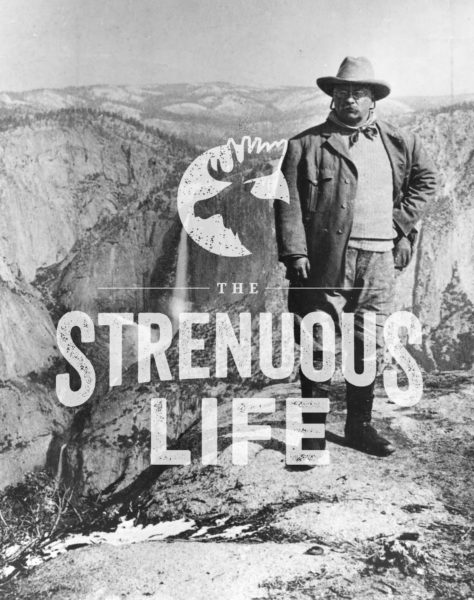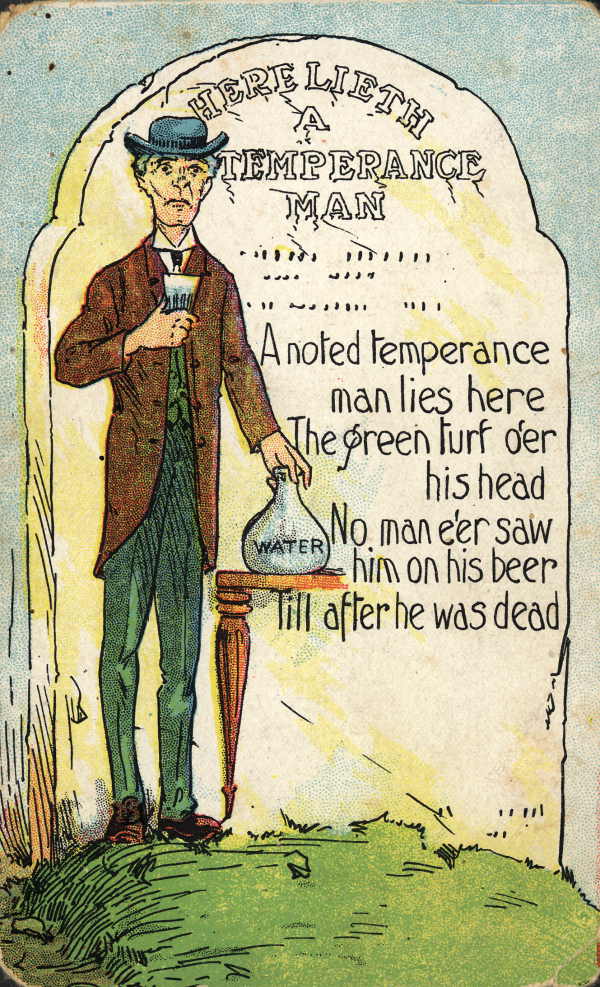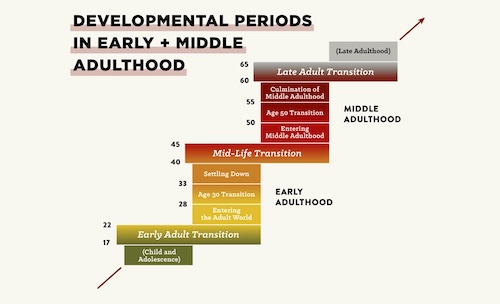
Ever since we did our in-depth series about the seasons of a man’s life (truly some of the most interesting articles we’ve written — I highly recommend reading them!), I’ve continued to think about human development, particularly in adulthood. Most books and articles on development focus on the transition between childhood and adolescence and adolescence to adulthood. People act as if no development happens after age twenty-five, which is weird. And certainly not the case!
We continue to grow and change in our 20s, 30s, 40s, and beyond. Researchers like Daniel Levinson have discovered that from birth through old age, individuals go through qualitatively different stages of life. Each season brings unique opportunities and challenges, and understanding what they are can help you navigate the landscape of mortality.
As I’ve researched more about the topic, I’ve discovered that humans have been dividing the human lifespan into distinct stages or steps across time and cultures. Depending on the culture, certain expectations and norms were established for each stage to help people know how to direct their lives. These stages of life, which ran from birth until death, served as a rough roadmap on how to live a good life.
Below, we highlight different ways writers, sages, and philosophers have divided up the lifespan. They’re interesting to contemplate and will perhaps give you some things to consider about the season you’re in now and the one you’ll transition to next.
Solon’s Stages of Life
Solon was the founder and lawgiver of ancient Athens. He was also a poet, and in one of the fragments we have of his verse, he divided human life into seven stages of ten years each. Seven and ten were intentional, as both were considered “perfect” or “complete” numbers in ancient Greece.
0-7: A boy at first is the man; unripe; then he casts his teeth; milk-teeth befitting the child he sheds his 7th year;
7-14: Then to his seven years God adding another seven, signs of approaching manhood show in the bud;
14-21: Still, in the third of the sevens his limbs are growing; his chin touched with a fleecy down; the bloom of the cheek gone;
21-28: Now in the 4th of the 7’s ripen to greatest completeness the powers of the man and his worth becomes plain to see;
28-35: In the fifth he bethinks him that this is the season for courting, bethinks him that sons will preserve and continue his line;
35-42: Now in the 6th his mind, ever open to virtue, broadens, and never inspires him to profitless deeds;
42-56: [Two stages combined] Seven times 7, and 8; the tongue and the mind for fourteen years together are now at their best;
56-63: Still in the ninth is he able, but never so nimble in speech and in wit as he was in the days of his prime;
63-70: Who to the tenth has attained, and has lived to complete it, has come to the time to depart on the ebb tide of death.
Ptolemy’s Life Stages of Man
The ancient Roman astronomer Ptolemy divided human life into seven stages. Interestingly, he described ages 41-55 as a time of unhappiness, and modern researchers have found that human happiness reaches its lowest point around age 47 or 48. The guy was ahead of his time!
Ptolemy described each stage of life as being marked by certain characteristics, which were influenced by different celestial bodies.
1-4: Inarticulate state of the soul. Governing celestial body: Moon
4-14: The logical part of the soul is formed. Governing celestial body: Mercury
14-22: Youth. Impulse toward the embrace of love. Governing celestial body: Venus
22-41: Soul masters action, seriousness. Governing celestial body: Sun
41-55: Unhappiness, desire to accomplish. Governing celestial body: Mars
56-68: Thoughtfulness, dignity. Governing celestial body: Jupiter
68-death: Cooling, slowing down, dispirited. Governing celestial body: Saturn
Horace’s Four Seasons of a Man’s Life
The Roman poet Horace depicted a man’s life going through four stages in his poem “Ars Poetica.” While he doesn’t give specific ages, his descriptions of the characteristics of each of the four life stages are interesting. (The words in brackets are original to the translation.)
Boyhood
The boy, who is just able to pronounce his words, and prints the ground with a firm tread, delights to play with his fellows, contracts and lays aside anger without reason, and is subject to change every hour.
Youth
The beardless youth, his guardian being at length discharged, joys in horses, and dogs, and the verdure of the sunny Campus Martius; pliable as wax to the bent of vice, rough to advisers, a slow provider of useful things, prodigal of his money, high-spirited, and amorous, and hasty in deserting the objects of his passion.
Manhood
[After this] our inclinations being changed, the age and spirit of manhood seeks after wealth, and [high] connections, is subservient to points of honor; and is cautious of committing any action, which he would subsequently be industrious to correct.
Old Age
Many inconveniences encompass a man in years; either because he seeks [eagerly] for gain, and abstains from what he has gotten, and is afraid to make use of it; or because he transacts every thing in a timorous and dispassionate manner, dilatory, slow in hope, remiss, and greedy of futurity. Peevish, querulous, a panegyrist of former times when he was a boy, a chastiser and censurer of his juniors. Our advancing years bring many advantages along with them. Many our declining ones take away. That the parts [therefore] belonging to age may not be given to youth, and those of a man to a boy, we must dwell upon those qualities which are joined and adapted to each person’s age.
Confucius’ Stages of Life
In the Analects, the ancient Chinese philosopher Confucius provides one of the earliest examples of the stages of life.
The Master said, at 15 I set my heart upon learning
At 30, I had planted my feet firm upon the ground.
At 40, I no longer suffered from perplexities.
At 50, I knew what were the biddings of heaven.
At 60, I heard them with docile ears.
At 70, I could follow the dictates of my own heart; for what I desired no longer overstepped the boundaries of right.
Native American Seasons of Life
In many Native American tribes, the Medicine Wheel served as a map for an individual journeying through mortality. Life is represented as passing through its four quadrants. Each quadrant represents a season of the year and an ordinal direction. The qualities of those environmental seasons (e.g., fertile/fallow) and directions (e.g., rising/setting) paralleled the mood of that stage of life.
Childhood
Season: Spring
Direction: East
Adolescence
Season: Summer
Direction: South
Adulthood
Season: Fall
Direction: West
Elderhood
Season: Winter
Direction: North
William Shakespeare’s Seven Ages of Man
Perhaps the most famous description of the life cycle of humans comes from William Shakespeare’s play As You Like It.
All the world’s a stage,
And all the men and women merely players;
They have their exits and their entrances;
And one man in his time plays many parts,
His acts being seven ages. At first the infant,
Mewling and puking in the nurse’s arms;
Then the whining school-boy, with his satchel
And shining morning face, creeping like snail
Unwillingly to school. And then the lover,
Sighing like furnace, with a woeful ballad
Made to his mistress’ eyebrow. Then a soldier,
Full of strange oaths, and bearded like the pard,
Jealous in honour, sudden and quick in quarrel,
Seeking the bubble reputation
Even in the cannon’s mouth. And then the justice,
In fair round belly with good capon lin’d,
With eyes severe and beard of formal cut,
Full of wise saws and modern instances;
And so he plays his part. The sixth age shifts
Into the lean and slipper’d pantaloon,
With spectacles on nose and pouch on side;
His youthful hose, well sav’d, a world too wide
For his shrunk shank; and his big manly voice,
Turning again toward childish treble, pipes
And whistles in his sound. Last scene of all,
That ends this strange eventful history,
Is second childishness and mere oblivion;
Sans teeth, sans eyes, sans taste, sans everything.
The Steps of Life
Beginning in the 15th century, writers and artists in the West started depicting the life course as going through 10 stages — each stage being a decade of life. Life was often depicted in a pyramid of ascending growth and subsequent decline.
Each 10-year span was associated with a different animal that described the characteristics of a person during that decade. The verse below accompanied a 19th-century depiction of the Steps of Life (pictured above).
Age 5 — Until the first five years be spent, a child is lamb-like, innocent.
Age 10 — At ten, goat-like, he skips and joys in idle sports and foolish toys.
Age 20 — At twenty, love doth swell his veins, and heifer-like, untamed remains.
Age 30 — With ox-like strength to smite his foes, at thirty to the field he goes.
Age 40 — At forty, naught his courage quails, but lion-like by force prevails.
Age 50 — Strength fails at fifty, but with wit, fox-like he helps to manage it.
Age 60 — At sixty repine, fraud and stealthy ways, wolf-like he tries his wealth to raise.
Age 70 — At seventy, news he’ll hear and tell, but dog-like loves at home to dwell.
Age 80 — The cat keeps house and loves the fire; at eighty we the same desire.
Age 90 — Weak donkey backs were made to bear; at ninety we must suffer everywhere.
Age 100 — If we should reach the hundredth year, tho’ sick of life, the grave we fear.







